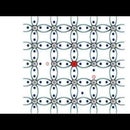Introduction: Kirchhoff's Rules
Introduction:
We know that single equivalent resistance, ( RT ) can be found when two or more resistors are connected together in either series if the same current value flows through all the components., parallel if they have the same voltage applied across them. or combinations of both, and that these circuits obey Ohm’s Law. However, sometimes in complex circuits such as bridge or T networks, we can not simply use Ohm’s Law alone to find the voltages or currents circulating within the circuit as in figure(1).
For these types of calculations, we need certain rules which allow us to obtain the circuit equations and for this we can use Kirchhoff’s Circuit Law.[1]
Step 1: Common Definition in Circuit Analysis:
Before we go into Kirchhoff's rules. we first will define basic things in circuit analysis which will be used in applying Kirchhoff's rules.
1-Circuit – a circuit is a closed-loop conducting path in which an electrical current flows.
2-Path – a single line of connecting elements or sources.
3-Node – a node is a junction, connection, or terminal within a circuit where two or more circuit elements are connected or joined together giving a connection point between two or more branches. A node is indicated by a dot.
4-Branch – a branch is a single or group of components such as resistors or a source which are connected between two nodes.
5-Loop – a loop is a simple closed path in a circuit in which no circuit element or node is encountered more than once.
6-Mesh – a mesh is a single closed loop series path that does not contain any other paths. There are no loops inside a mesh.
Step 2: Kirchhoff’s Two Rules:
Step 3: Applying Kirchhoff’s Rules:
We will use this circuit to apply both KCL and KVL as follow:
1-Divide circuit into several loops.
2-Set direction of currents using KCL. Set 2 currents direction as you want, then use them to get the direction of the third one as follows in figure(4).
Using Kirchhoff's Current Law, KCL
At node A : I1 + I2 = I3
At node B : I3 = I1 + I2 Using Kirchhoff's Voltage Law, KVL
the equations are given as: Loop 1 is given as : 10 = R1 (I1) + R3 (I3) = 10(I1) + 40(I3)
Loop 2 is given as : 20 = R2 (I2) + R3 (I3) = 20(I2)+ 40(I3)
Loop 3 is given as : 10 – 20 = 10(I1) – 20(I2)
As I3 is the sum of I1 + I2 we can rewrite the equations as; Eq. No 1 : 10 = 10I1 + 40(I1 + I2) = 50I1 + 40I2 Eq. No 2 : 20 = 20I2 + 40(I1 + I2) = 40I1 + 60I2
We now have two “Simultaneous Equations” that can be reduced to give us the values of I1 and I2 Substitution of I1 in terms of I2 gives us
the value of I1 as -0.143 Amps Substitution of I2 in terms of I1 gives us the value of I2 as +0.429 Amps
As : I3 = I1 + I2 The current flowing in resistor R3 is given as : I3= -0.143 + 0.429 = 0.286 Amps
and the voltage across the resistor R3 is given as : 0.286 x 40 = 11.44 volts
The negative sign for I1 means that the direction of the current flow initially chosen was wrong, but nevertheless still valid. In fact, the 20v battery is charging the 10v battery.[2]
Step 4: KiCAD Schematic of Circuit:
Steps of opening kicad:
Step 5: Steps of Drawing Circuit in Kicad:
Step 6: Multisim Simulation of Circuit:
Note:
Kirchhoff’s rule can be applied for both AC and DC circuits where in case AC the resistance will include capacitor and coil not only ohmic resistance.
Step 7: Reference:
[1]https://www.electronics-tutorials.ws/dccircuits/dcp_4.html
[2]https://www.britannica.com/science/Kirchhoffs-rules











